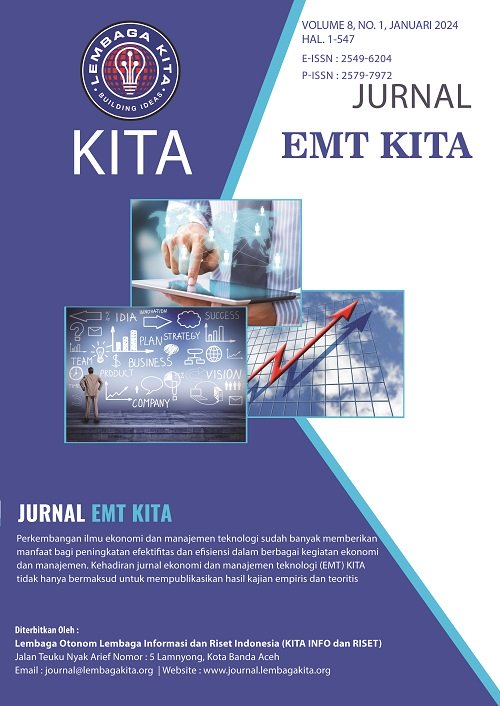Evaluasi Efektivitas Iklan Aero Street di Media Sosial dengan Consumer Decision Model (CDM)
Main Article Content
Abstract
Social media advertising plays a crucial role in marketing. This research evaluates the influence of advertising messages and Brand recognition on consumer Attitudes on social media, using the Consumer Decision Model (CDM) on Aero Street advertising. A total of 100 respondents were selected through purposive sampling. Data was collected through questionnaires and analyzed using multiple linear regression. The results show that the advertising message variables (I, Information) and Brand recognition (B, Brand recognition) have a positive effect on consumer Attitudes (A, Attitude), such as A = 2.172 + 0.229F + 0.258B. The calculated F statistical test is 19.005, exceeding the F table of 3.090, indicating a significant joint influence. The advertising message and Brand recognition variables simultaneously and partially have a significant effect on consumer Attitudes, showing the effectiveness of Aero Street advertising on social media with CDM.
Downloads
Article Details

This work is licensed under a Creative Commons Attribution-NonCommercial-NoDerivatives 4.0 International License.
An author  who publishes in the  Jurnal Manajemen Teknologi agrees to the following terms:
- Author retains the  copyright and grants the journal the right of first publication of  the work simultaneously licensed under the Creative Commons Attribution License that allows others to share the work with an acknowledgement of the work's authorship and initial publication in this journal.
- Author is  able to enter into separate, additional contractual arrangements for the non-exclusive distribution of the journal's published version of the work (e.g., post it to an institutional repository or publish it in a book)with the  acknowledgement of its initial publication in this journal.
- Author is  permitted and encouraged to post his/her  work online (e.g., in institutional repositories or on their website) prior to and during the submission process, as it can lead to productive exchanges, as well as earlier and greater citation of the published work (See The Effect of Open Access).
 Jurnal Ekonomi Manajemen Teknologi (EMT) KITA by http://journal.lembagakita.org/index.php/emt/index is licensed under a Creative Commons Attribution-ShareAlike 4.0 International License.
Jurnal Ekonomi Manajemen Teknologi (EMT) KITA by http://journal.lembagakita.org/index.php/emt/index is licensed under a Creative Commons Attribution-ShareAlike 4.0 International License.
References
Ahlse, J., Nilsson, F., & Sandström, N. (2020). It's time to TikTok: Exploring Generation Z's motivations to participate in# Challenges.
Ashley, C., & Tuten, T. (2015). Creative strategies in social media marketing: An exploratory study of branded social content and consumer engagement. Psychology & marketing, 32(1), 15-27.
Azizan, N. S., & Yusr, M. M. (2019). The influence of customer satisfaction, brand trust, and brand image towards customer loyalty. International Journal of Entrepreneurship, 2(7), 93-108.
Deeter-Schmelz, D. R., Kennedy, K. N., & Goebel, D. J. (2002). Understanding sales manager effectiveness: Linking attributes to sales force values. Industrial Marketing Management, 31(7), 617-626.
Dewi, Y. R. (2021). Creating Customer Engangement and Customer Value within 15 second: How Tiktok Works for Content Marketing. AMAR (Andalas Management Review), 5(1), 33-45.
Dwivedi, Y. K., Hughes, L., Wang, Y., Alalwan, A. A., Ahn, S. J., Balakrishnan, J., ... & Wirtz, J. (2023). Metaverse marketing: How the metaverse will shape the future of consumer research and practice. Psychology & Marketing, 40(4), 750-776.
Hashim, N. H., Normalini, & Sajali, N. (2018). The influence factors towards mobile advertising message content on consumer purchase intention. Global Business Review, 19(5), 1187-1206.
Hulland, J., Baumgartner, H., & Smith, K. M. (2018). Marketing survey research best practices: evidence and recommendations from a review of JAMS articles. Journal of the Academy of Marketing Science, 46, 92-108.
Milner, T., & Rosenstreich, D. (2013). A review of consumer decision-making models and development of a new model for financial services. Journal of Financial Services Marketing, 18, 106-120.
Nam, J., Ekinci, Y., & Whyatt, G. (2011). Brand equity, brand loyalty and consumer satisfaction. Annals of tourism Research, 38(3), 1009-1030.
Oppenheimer, A. (2005). From experience: products talking to people—conversation closes the gap between products and consumers. Journal of Product Innovation Management, 22(1), 82-91.
Purba, P., & Tafonao, H. (2023). Pengaruh Harga dan Media Sosial Instagram Terhadap Minat Beli Handphone Oppo pada Toko Oppo di Plaza Millenium. Jurnal EMT KITA, 7(3), 637-646.
Rabindranath, M., & Singh, A. K. (2024). Introduction to Advertising. In Advertising Management: Concepts, Theories, Research and Trends (pp. 3-38). Singapore: Springer Nature Singapore.
Schivinski, B., & Dabrowski, D. (2016). The effect of social media communication on consumer perceptions of brands. Journal of Marketing Communications, 22(2), 189-214.
Sufyan, S. (2016). Analisis Efektivitas Iklan Produk Mobil Toyota Avanza di Kota Banda Aceh. Jurnal Ekonomi Manajemen dan Sekretari, 1(1), 20-26.
Sun, Z., Sun, J., & Meredith, G. (2012). Customer decision making in Web services with an integrated P6 model. Physics Procedia, 24, 1553-1559.
Sutherland, M. (2020). Advertising and the mind of the consumer: what works, what doesn't and why. Routledge.
Tsimonis, G., & Dimitriadis, S. (2014). Brand strategies in social media. Marketing Intelligence & Planning, 32(3), 328-344.
Wali, M., Amri, K., Rizal, S., & Salam, A. (2022). Sosialisasi Peluang Home Business dalam Ekonomi Digital. Kawanad: Jurnal Pengabdian kepada Masyarakat, 1(1), 24-30.
Wijayanto, G., Sakkir, G., Sukmasetya, P., Arikarani, Y., Leo, M., Safitri, N.M., Wali, M., Zaenurrohman, J.A., Vikaliana, R., Madiawati, P.N. and Sianipar, M.Y. (2022). Metode Riset Berbasis Digital Penelitian Pasca Pandemi. Media Sains Indonesia.
Zhou, Q. (2019). Understanding user behaviors of creative practice on short video sharing platforms-a case study of TikTok and Bilibili (Doctoral dissertation, University of Cincinnati).

